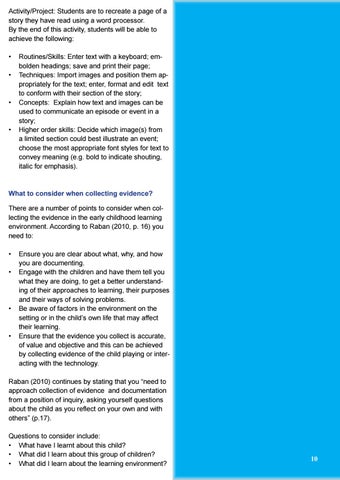Activity/Project: Students are to recreate a page of a story they have read using a word processor. By the end of this activity, students will be able to achieve the following: • Routines/Skills: Enter text with a keyboard; embolden headings; save and print their page; • Techniques: Import images and position them appropriately for the text; enter, format and edit text to conform with their section of the story; • Concepts: Explain how text and images can be used to communicate an episode or event in a story; • Higher order skills: Decide which image(s) from a limited section could best illustrate an event; choose the most appropriate font styles for text to convey meaning (e.g. bold to indicate shouting, italic for emphasis).
What to consider when collecting evidence? There are a number of points to consider when collecting the evidence in the early childhood learning environment. According to Raban (2010, p. 16) you need to: • Ensure you are clear about what, why, and how you are documenting. • Engage with the children and have them tell you what they are doing, to get a better understanding of their approaches to learning, their purposes and their ways of solving problems. • Be aware of factors in the environment on the setting or in the child’s own life that may affect their learning. • Ensure that the evidence you collect is accurate, of value and objective and this can be achieved by collecting evidence of the child playing or interacting with the technology. Raban (2010) continues by stating that you “need to approach collection of evidence and documentation from a position of inquiry, asking yourself questions about the child as you reflect on your own and with others” (p.17). Questions to consider include: • What have I learnt about this child? • What did I learn about this group of children? • What did I learn about the learning environment?
10











